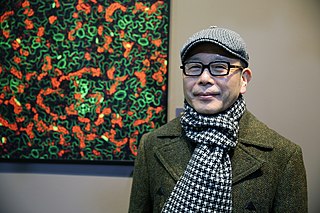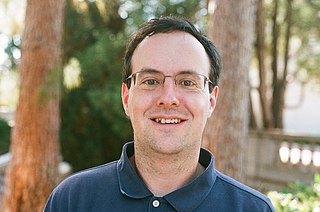In mathematics, a symplectomorphism or symplectic map is an isomorphism in the category of symplectic manifolds. In classical mechanics, a symplectomorphism represents a transformation of phase space that is volume-preserving and preserves the symplectic structure of phase space, and is called a canonical transformation.

Andreas Floer was a German mathematician who made seminal contributions to symplectic topology, and mathematical physics, in particular the invention of Floer homology. Floer's first pivotal contribution was a solution of a special case of Arnold's conjecture on fixed points of a symplectomorphism. Because of his work on Arnold's conjecture and his development of instanton homology, he achieved wide recognition and was invited as a plenary speaker for the International Congress of Mathematicians held in Kyoto in August 1990. He received a Sloan Fellowship in 1989.
In mathematics, Floer homology is a tool for studying symplectic geometry and low-dimensional topology. Floer homology is a novel invariant that arises as an infinite-dimensional analogue of finite-dimensional Morse homology. Andreas Floer introduced the first version of Floer homology, now called symplectic Floer homology, in his proof of the Arnold conjecture in symplectic geometry. Floer also developed a closely related theory for Lagrangian submanifolds of a symplectic manifold. A third construction, also due to Floer, associates homology groups to closed three-dimensional manifolds using the Yang–Mills functional. These constructions and their descendants play a fundamental role in current investigations into the topology of symplectic and contact manifolds as well as (smooth) three- and four-dimensional manifolds.

Ciprian Manolescu is a Romanian-American mathematician, working in gauge theory, symplectic geometry, and low-dimensional topology. He is currently a professor of mathematics at Stanford University.

Clifford Henry Taubes is the William Petschek Professor of Mathematics at Harvard University and works in gauge field theory, differential geometry, and low-dimensional topology. His brother is the journalist Gary Taubes.
The Geometry Festival is an annual mathematics conference held in the United States.

Paul Seidel is a Swiss-Italian mathematician specializing in homological mirror symmetry. He is a faculty member at the Massachusetts Institute of Technology.
In symplectic topology, a Fukaya category of a symplectic manifold is a category whose objects are Lagrangian submanifolds of , and morphisms are Lagrangian Floer chain groups: . Its finer structure can be described as an A∞-category.

Kenji Fukaya is a Japanese mathematician known for his work in symplectic geometry and Riemannian geometry. His many fundamental contributions to mathematics include the discovery of the Fukaya category. He is a permanent faculty member at the Simons Center for Geometry and Physics and a professor of mathematics at Stony Brook University.

Hong Gil Nam is a South Korean biologist teaching in the Department of New Biology of Daegu Gyeongbuk Institute of Science and Technology and leading research as director of the Center for Plant Aging Research. His research interests include comparative aging in diverse kingdoms, including plant and animals, to reveal aging mechanisms among species, cross-kingdom interaction between plants and animals, and biochemistry at nano and micro levels. He is the founder and former director of the Biological Research Information Center, a member of the Korean Academy of Science and Technology, and has served on the editorial board in Molecular Plant since 2013.
In mathematics, especially in topology, a Kuranishi structure is a smooth analogue of scheme structure. If a topological space is endowed with a Kuranishi structure, then locally it can be identified with the zero set of a smooth map , or the quotient of such a zero set by a finite group. Kuranishi structures were introduced by Japanese mathematicians Kenji Fukaya and Kaoru Ono in the study of Gromov–Witten invariants and Floer homology in symplectic geometry, and were named after Masatake Kuranishi.
This is a glossary of properties and concepts in symplectic geometry in mathematics. The terms listed here cover the occurrences of symplectic geometry both in topology as well as in algebraic geometry. The glossary also includes notions from Hamiltonian geometry, Poisson geometry and geometric quantization.
François Lalonde is a Canadian mathematician, specializing in symplectic geometry and symplectic topology.
Kaoru Ono is a Japanese mathematician, specializing in symplectic geometry. He is a professor at the Research Institute for Mathematical Sciences (RIMS) at Kyoto University.
Ivan Smith is a British mathematician who deals with symplectic manifolds and their interaction with algebraic geometry, low-dimensional topology, and dynamics. He is a professor at the University of Cambridge.
Dietmar Arno Salamon is a German mathematician.

Yong Seung Cho is a South Korean educator and mathematician. He completed a Ph.D. in mathematics in 1987 at the University of Chicago. His research interests include geometric topology, Yang-Mills Theory, Seiberg-Witten Theory, Gromov-Witten Theory, and Quantum cohomology of symplectic manifolds. His teaching career includes Chungbuk National University, Kyungpook National University, Brandeis University, and Ewha Womans University. Currently he teaches at Sungkyunkwan University as Invited Professor. In 2003, he was elected as President of the Korean Mathematical Society (KMS), and at the position, he played a pivotal role in establishing the National Institute for Mathematical Sciences (NIMS) in South Korea, the first national mathematical research center directly funded by the South Korean government. In 2005, he was selected as the first President of NIMS, and immediately began to set-up fundamental foundation of the NIMS to be innovative hub of the mathematical researches contributing to South Korea's overall scientific and industrial competitiveness.

Changjoon Justin Lee is an American neuroscientist specializing in the field of glioscience. He served as the Director of Center for Neuroscience at the Korea Institute of Science and Technology and later founded the WCI Center for Functional Connectomics as part of the World Class Institute Program. In 2015, he established the Center for Glia-Neuron Interaction before becoming co-director of the IBS Center for Cognition and Sociality and head of the Cognitive Glioscience Group in 2018. He has been on the editorial boards of the journals Molecular Brain and Molecular Pain and is a chief editor of Experimental Neurobiology.

Denis Auroux is a French mathematician working in geometry and topology.
The Arnold conjecture, named after mathematician Vladimir Arnold, is a mathematical conjecture in the field of symplectic geometry, a branch of differential geometry.









